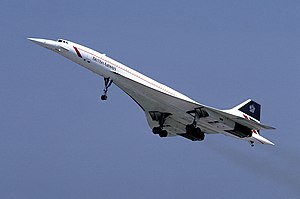
Back Concorde Afrikaans Concorde AN كونكورد Arabic Concorde AST Konkord Azerbaijani Aérospatiale-BAC Concorde Byelorussian Канкорд BE-X-OLD Конкорд (самолет) Bulgarian কনকর্ড Bengali/Bangla Concorde Breton
| Concorde | |
|---|---|

| |
| British Airways Concorde in flight during 1986 | |
| Role | Supersonic airliner |
| National origin | France and United Kingdom |
| Manufacturer |
|
| First flight | 2 March 1969 |
| Introduction | 21 January 1976 |
| Retired |
|
| Status | Retired |
| Primary users | British Airways Air France See Operators below for others |
| Produced | 1965–1979 |
| Number built | 20 (including 6 non-commercial aircraft)[2][3] |
Concorde (/ˈkɒŋkɔːrd/) is a retired Anglo-French supersonic airliner jointly developed and manufactured by Sud Aviation (later Aérospatiale) and the British Aircraft Corporation (BAC). Studies started in 1954, and France and the UK signed a treaty establishing the development project on 29 November 1962, as the programme cost was estimated at £70 million (£1.39 billion in 2023). Construction of the six prototypes began in February 1965, and the first flight took off from Toulouse on 2 March 1969. The market was predicted for 350 aircraft, and the manufacturers received up to 100 option orders from many major airlines. On 9 October 1975, it received its French Certificate of Airworthiness, and from the UK CAA on 5 December.[4]
Concorde is a tailless aircraft design with a narrow fuselage permitting 4-abreast seating for 92 to 128 passengers, an ogival delta wing and a droop nose for landing visibility. It is powered by four Rolls-Royce/Snecma Olympus 593 turbojets with variable engine intake ramps, and reheat for take-off and acceleration to supersonic speed. Constructed out of aluminium, it was the first airliner to have analogue fly-by-wire flight controls. The airliner could maintain a supercruise up to Mach 2.04 (2,170 km/h; 1,350 mph) at an altitude of 60,000 ft (18.3 km).
Delays and cost overruns increased the programme cost to £1.5–2.1 billion in 1976, (£9–13.2 billion in 2023). Concorde entered service on 21 January 1976 with Air France from Paris-Roissy and British Airways from London Heathrow. Transatlantic flights were the main market, to Washington Dulles from 24 May, and to New York JFK from 17 October 1977. Air France and British Airways remained the sole customers with seven airframes each, for a total production of twenty. Supersonic flight more than halved travel times, but sonic booms over the ground limited it to transoceanic flights only.
Its only competitor was the Tupolev Tu-144, carrying passengers from November 1977 until a May 1978 crash, while a potential competitor, the Boeing 2707, was cancelled in 1971 before any prototypes were built.
On 25 July 2000, Air France Flight 4590 crashed shortly after take-off with all 109 occupants and four on the ground killed. This was the only fatal incident involving Concorde; commercial service was suspended until November 2001. The Concorde aircraft were retired in 2003, 27 years after commercial operations had begun. All but 2 of the 20 aircraft built have been preserved and are on display across Europe and North America.
- ^ Cite error: The named reference
jlfinwas invoked but never defined (see the help page). - ^ Towey 2007, p. 359.
- ^ "Ageing luxury jet". BBC News. 25 July 2000. Archived from the original on 14 March 2009. Retrieved 13 November 2006.
- ^ "Concorde Special - Concorde timeline". FlightGlobal. 21 October 2003.
© MMXXIII Rich X Search. We shall prevail. All rights reserved. Rich X Search